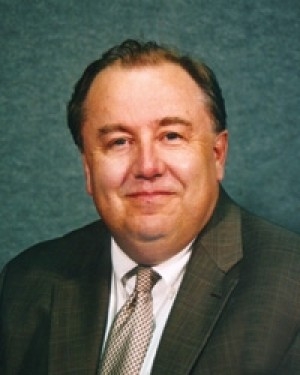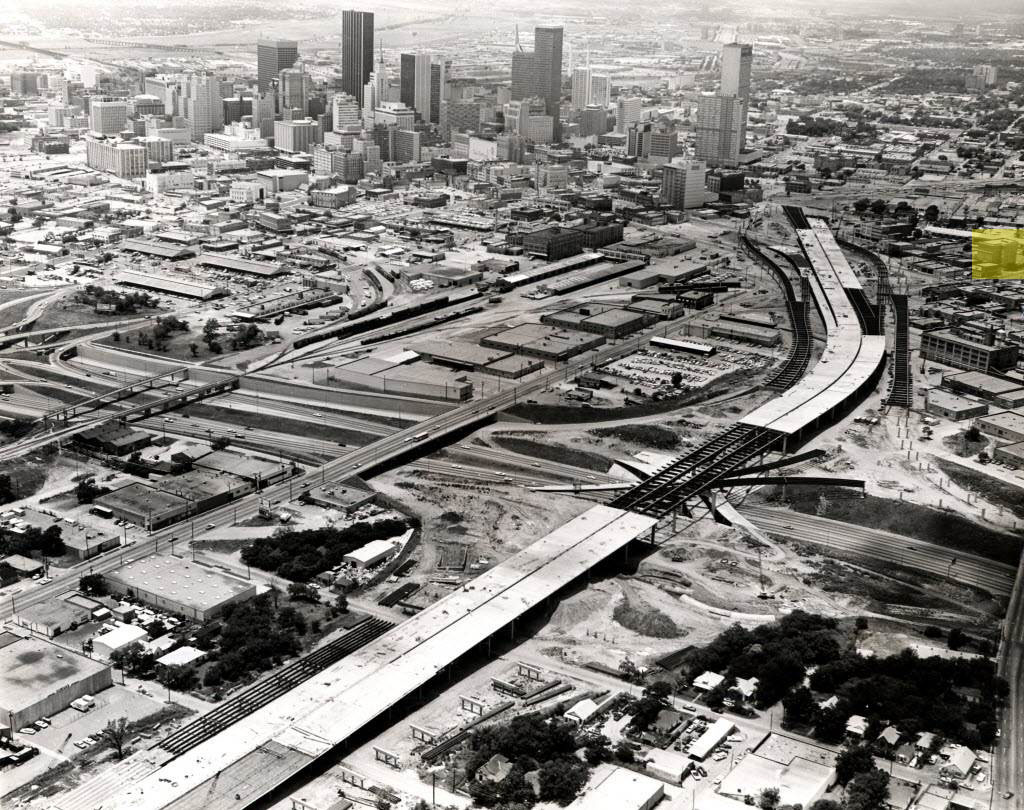Michael Morris, the most powerful transportation official in North Texas, is ready to be done with I-345.
The Texas Department of Transportation would prefer to trench the highway 65 feet below ground, on the east side of downtown, which would allow traffic to flow and development to come on decks over the roadway and on surplus right of way. But some on the Dallas City Council still have questions about how this would affect the city generations from now.
Morris, the transportation director of the North Central Texas Council of Governments, believes that this is a simple decision. There is money in Washington and in Austin, and that money can be spent tearing the freeway down, digging a 65-foot-deep trench, laying as many as 10 lanes in that depression, and reconnecting existing streets over the below-ground freeway.
Later, Morris says, the city and his organization can figure out all the economic development potential surrounding this project, including how to pay for decks over the freeway that could hold some manner of buildings or parks. The COG, as his organization is known, helps secure state and federal dollars for major infrastructure projects like this one.
And this one is indeed major. TxDOT’s trenching plan—the so-called “hybrid” plan—will cost at least $1 billion and will require years of construction. The state won’t pay for decking, and the city will have to purchase surplus right of way freed up when ramps are torn out.
“Make hay while the sun shines,” Morris said last Monday night, May 8, during a specially called panel of top city staffers, prominent developers, and representatives for downtown and Deep Ellum. It was the unofficial kickoff to a month of policy decisions that will end with the City Council either giving its support for the state’s trenching plan or continuing to study other possible plans for I-345.
The trench would maintain the highway’s present ties to Central Expressway, Woodall Rodgers, and interstates 30 and 45. But it would also create a huge chasm between downtown and Deep Ellum, which makes some on the City Council nervous.
“I absolutely don’t want to close the door on a boulevard opportunity,” said Councilman Jesse Moreno after the meeting. His district includes Deep Ellum.
Morris believes that there is presently no money or political appetite at the highest levels of government to remove the highway and replace it with a boulevard. At Monday’s meeting, he seemed exhausted by the idea. Monday’s panel was, more than anything, a pep rally for the trench boosters. There was no new information provided, outside of an aggressive argument for city officials to rally behind the below-grade freeway.
“I actually deal in reality,” Morris said. “My plea to the group: can we come together today to rally around what is a brilliant, proposed strategy by TxDOT?”
The 50-year-old highway is nearing the end of its lifespan, and the state is looking for direction from the city on how to move forward. It’s a tricky arrangement. Texas owns the thoroughfare itself—345 is among the shortest highways on the national system, considered a stub that connects other freeways—but it obviously exists within the city limits.
Dallas doesn’t have jurisdiction over the road; the state does. But TxDOT looks for resolutions in support from cities in which its projects are located before it pursues funding. The Dallas City Council is expected to vote on that resolution during its May 24 meeting. If the body does not offer its support, it could effectively stall years of planning. The Transportation and Infrastructure Committee will be briefed this afternoon.
Monday’s public panel came about because a few council members weren’t ready to vote on the resolution when it first landed on a meeting agenda, in February.
Omar Narvaez, the chair of the Council’s Transportation and Infrastructure Committee, directed staff to put together a public panel to iron out concerns. He said he wanted a “general public discussion prior to any vote.” The panel on Monday was largely composed of those in favor of TxDOT’s plan, a time for Morris to ask opponents to join his team.
Many of the assistant city managers over various departments—housing, planning and zoning, economic development, parks, and transportation—spoke broadly about the project. But in some ways, their responses highlighted the concerns of council members who say the city is moving too fast, even after a dozen years of planning from the state.
Julia Ryan, the head of the city’s planning and zoning department, acknowledged that the “original construction of this roadway had detrimental effects on the surrounding African American community.” The construction of I-345 wiped out a prominent Black center of commerce.
“The city does not have an adopted future land use plan that sets a vision for the development or redevelopment around the structure,” Ryan said.
Kevin Spath, the assistant director for economic development, questioned the cost of acquiring land and building on top of decks.
“Are there structural limitations about how to develop on top of a cap and what densities could be developed on top of a cap?” he asked. “These are all the questions that would need to be answered, frankly, before our office could really get in the high gear on implementing a plan and facilitating development on property that the city would become owners of.”
David Noguera, the director of housing, said he “was commenting to Michael Morris last week that I’ve only been exposed to this for the last 15 minutes, while he’s been working on this for the last 15 years.”
He, too, noted the damage the highway had inflicted on the people who operated businesses in the corner of Deep Ellum where a stretch of the highway now sits. “We have an opportunity to reconnect” these areas, he said, but “how we do that is up for debate, right? I believe that the hybrid [trench] option does offer a way to integrate that” connectivity.
Developer Jack Matthews, of Matthews Southwest, owns land near the convention center and in the Cedars. “From a developer, investment standpoint,” he said, “I need to know what the future is, and I have to have confidence that cities and states are going to work at a certain level. I don’t want to be the experiment.”
The one voice on the panel that was critical of the hybrid plan was Patrick Kennedy, the urban planner, SMU professor, and DART board member who first presented the idea to remove the highway and replace it with a boulevard.
He called for the City Council to pursue a federal grant through the Biden Administration’s Reconnecting Communities Pilot Program that could pay for another study to explore the impact of removal. TxDOT has said it will not study the boulevard option further because of the congestion its traffic models predict. Too, the governor has ordered TxDOT’s bosses not to fund any projects that would lessen vehicle capacity on state-owned roadways. It has already taken back a project in San Antonio to turn a state highway into a boulevard.
“I’m actually advocating that we don’t move forward,” Kennedy said, “that we don’t rush through any of these particular options right now.”
That is what Morris fears, because the City Council can do just that. The body will consider another matter on May 24: stalling the resolution vote until the completion of an independent study into the options around removing the highway. This consideration came at the request of five council members who wanted more information about how the future of I-345 would affect Dallas’ land use, including, yes, how traffic would flow, but also the opportunities for adding additional housing, office, retail, and other uses if the highway was not there. Climate concerns also hover over the matter; how would a boulevard affect emissions?

“Just because we have an opportunity for funding does not mean that we should move forward with a project that hasn’t been well thought out,” said Moreno, the Deep Ellum councilman, in an interview after the meeting. “If we are going to approve any plan moving forward, I want to know what exactly we’re getting ourselves into.”
Morris spoke of the need for “more infill development in the center of the region.”
“I can’t let the region develop to the Red River,” he said.
But that is what’s happening. I-345, he said, “is a key corridor” that “connects the Port of Houston up to Sherman.” And despite what Morris says, the COG predicts most of the population growth coming to Dallas’ neighbors. The city of Dallas has essentially stopped growing since 2017, ceding growth to suburban counties like Collin and Denton. Too, the COG’s priority transportation projects are, by and large, regional highway expansions that will further sprawl. “We all know what’s happening in Sherman, as far as the chips and manufacturing,” he said, referring to T.I.’s $30 billion semiconductor factory and other production facilities.
Dallas’ advantage over the suburbs is in its potential infill development and added density. If the city manages to buck its stagnant population growth over the past half-decade or so to add the 1 million new residents the COG predicts it will, Dallas will need to update what is legal to build to accommodate greater density.
The highways that 345 bridges together fueled the success of the suburbs by way of sprawl. Proponents are so high on removal because of the potential for creating a true urban neighborhood in the heart of the city’s core. It would require changes to existing land use policies to allow for more housing developments beyond single-family. That’s part of what supporters of the boulevard option would like to see researched further.
Morris maintains that the highway is necessary for southern Dallas residents who use it for jobs in points north. But, as noted by Councilwoman Gay Donnell Willis earlier this year, what will it mean for 345 if the city is successful in bringing jobs and economic development to southern Dallas? Would it be necessary then?
“I can’t let the region develop to the Red River.”
Michael Morris, transportation director for the North Central Texas Council of Governments
“What if that changes tremendously,” asked Willis, Preston Hollow’s representative, “where you have great opportunities for jobs, shopping, et cetera in the southern sector? How do we model that?”
That is one of the reasons Willis joined four of her colleagues in asking for another study, independent of TxDOT, into the road’s future.
The table is set. TxDOT first began researching the future of I-345 a dozen years ago, when it produced a document known as CityMAP (for “Master Assessment Process”). That document explored how best to address the highways that crisscross Dallas’ urban core. Removing 345 was one of the possibilities, but navigating the political reality of today is a different game.
Morris was clear on that matter.
“I have to deal with the reality of what our responsibility is,” he said. “We have a national government that has a whole bunch of money right now. My board of directors want to get as much of that money in Dallas-Fort Worth as we can. Chairman Narvaez from the city has challenged us to get as much back for the city of Dallas.
“We’re the adults in the room here. We’re all here on a Monday night. We’re the adults. We’re the ones that are being asked to give advice to the elected officials. If we could come to grips to argue, let’s depress the freeway so we don’t have to look at the overhead facility. Let’s try to get it fast-tracked … . Let’s get as much of this money as we possibly can. Let’s continue to refine the project … . Let’s rally around the depressed facility.”
He needs just eight City Council votes to do it.
Get the D Brief Newsletter
Author





